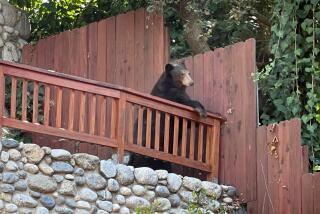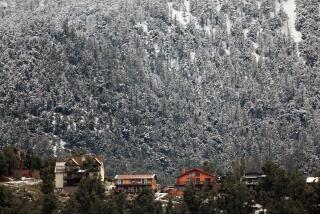Anchorage Residents Are a Soft Touch for Their Bears
- Share via
ANCHORAGE — Anchorage is one bear-friendly city.
The community’s 260,000 residents share their town with dozens of black bears and at least 15 grizzlies.
There’s not another city in the United States that would cozy up to bears the way people in Anchorage do, said Rick Sinnott, area biologist for the Alaska Department of Fish and Game.
Sinnott should know. He’s the one who gets most of the calls about nuisance bears.
University of Alaska Anchorage student Chris Kleckner, who is finishing up a two-year study of urban bears, agrees.
“They’re around,” he said. “This is pretty unique.”
The department conducted a survey four years ago in which 75% of the city’s residents said the number of bears was just about right.
“Most people like the idea of bears in town,” Sinnott said. “As long as people have the attitude that the risk is small and we like to have some bears around, they will keep moving in.”
Last summer, Sinnott received about 1,200 calls from residents worried about the bear that had just tromped through the backyard, had gotten into the garbage or was caught snoozing on the deck.
“Frequently the bears have gotten into some kind of trouble,” Sinnott said.
Most of Anchorage’s bears wander into the city from Chugach State Park, nearly a half-million acres of wilderness located on the city’s doorstep. The bears follow creek beds and greenways. Once in Anchorage, most are content to stay out of the way and eat berries, or snatch the occasional moose calf.
But homeowners who witness hungry bears dragging moose calves off into the brush can become alarmed for the safety of their children, Sinnott said. No wonder.
“They hear the sound of crunching bones . . . the bear kind of grunting and slurping out the marrow,” Sinnott said.
He advises them to keep their children inside for a while.
Bears kill 10 or more dogs a year in Anchorage. They snatch bunnies from hutches, grab chickens and chase llamas and horses. Storage sheds are broken into, bird feeders torn down.
“No one else would tolerate it,” Sinnott said of Anchorage residents.
That wasn’t always the case. If a bear wandered into the city 20 years ago, it likely was shot, no questions asked. Hunting regulations allowed it, but those rules have changed.
Still, state law permits people to shoot bears that are threatening life or property. About 10 bears are shot each year in Anchorage.
While Sinnott can’t remember a time when a bear killed a human in the city, encounters are becoming more common as Anchorage expands. Without hunting, bears have become bolder, he said.
“They don’t see humans as a big threat,” Sinnott said.
More than 90% of the calls are coming from the Hillside, a neighborhood of upscale homes on large lots that border the state park.
“They build right up to the edge of the park,” Sinnott said.
Another problem area is Eagle River, a burgeoning suburb 15 miles north of downtown adjacent to the Chugach Mountains.
Last summer in Eagle River, a bear was killed after charging a 4-year-old girl who was out in her yard with her two dogs. The same night in south Anchorage, a homeowner shot a bear after it charged him and ran off with a chicken.
Two months later, a bear chased a man who had just left a bar in downtown Anchorage.
“They have become pretty habituated to human beings. That’s why they’re around,” Kleckner said. “There is no fear factor anymore.”
Sinnott and Kleckner say bears aren’t the problem; it’s humans. Anchorage residents give bears too many reasons to wander up the driveway and start poking around: garbage put out before trash day, cat and dog food bowls left out and bags of birdseed--bears love birdseed.
Once bears taste human food, their futures quickly turn bleak. Even when relocated hundreds of miles into the wilderness, they somehow find their way to humans.
More to Read
Sign up for Essential California
The most important California stories and recommendations in your inbox every morning.
You may occasionally receive promotional content from the Los Angeles Times.













